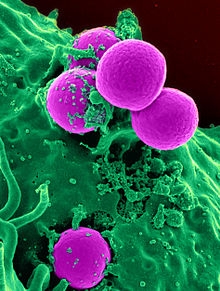Ancient recipe holds key to fighting MRSA
01 Apr 2015
A potion from Europe's Dark Ages has come back to life again, as scientists have found that it could be more effective than current treatments for Methicillin-resistant Staphylococcus aureus (MRSA) infections.
 | |
| Scanning electron micrograph of a human neutrophil ingesting MRSA |
The 10th-century formula comprises garlic, wine and cow stomach bile - a combination that would churn the stomach of a modern consumer. But researchers have found that it outperforms conventional antibiotics.
After a series of tests in Britain and the US during the past year, scientists say they are ''dumbfounded'' at the bug-killing ability of the potion, originally meant as a cure for eye infections.
That the Anglo-Saxon recipe could hold the key to defeating MRSA came about after a chance discussion between experts at the University of Nottingham last year.
During a meeting of academics interested in infectious diseases, Dr Christina Lee, an expert in Old English, told microbiologists about Bald's Leechbook - an Anglo-Saxon medical textbook kept in the British Library which contains remedies for treating infections and other ailments.
Dr Lee translated a recipe for treating styes - an infection of an eyelash usually caused by Staphylococcus aureus - and the past year has seen researchers painstakingly recreate it and test it on MRSA.
The thousand-year-old remedy has proven to be an ''incredibly potent'' antibiotic, according to lead researcher Dr Freya Harrison, a microbiologist from the University of Nottingham.
The individual ingredients alone did not have any measurable effect but when combined according to the ancient text, they killed up to 90 per cent of MRSA bacteria in infected mice. And in infections grown in the laboratory, only about one bacterial cell in a thousand survived.
''I still can't quite believe how well this one thousand year old antibiotic actually seems to be working, when we got the first results we were just utterly dumbfounded. We did not see this coming at all,'' commented Dr Harrison.
The findings will be presented at the Society for General Microbiology's annual conference in Birmingham this week and will be submitted to the global science journal Nature soon after.
''Modern research into disease can benefit from past responses and knowledge, which is largely contained in non-scientific writings. But the potential of these texts to contribute to addressing the challenges cannot be understood without the combined expertise of both the arts and science,'' commented Dr Lee.
Dr Kendra Rumbaugh, a microbiologist at Texas Tech University who was part of the research team, commented, ''These types of wound infections are very difficult to treat, and given that most of the agents we have previously tested displayed little to no efficacy, I was quite sceptical. However, this 'ancient' solution performed better than the current 'gold standard' (vancomycin) and killed more than 90 per cent of the MRSA in the wounds.''
And this is just the start. For the initial success of the research is prompting scientists to look at nine other recipes from the Anglo-Saxon book.
The original formula reads almost like Shakespeare's 'Tail of newt, and baboon's blood'.
''Work and eye salve for a wen, take cropleek and garlic, of both equal quantities, pound them well together, take wine and bullocks gall, of both equal quantities, mix with a leek, put this then into a brazen vessel, let it stand nine days in the brass vessel, wring out through a cloth and clear it well, put it into a horn, and about night time apply with a feather to the eye; the best leechdom,'' it prescribes.






























